Identification of synoviocyte activation inhibitors by parallel ...
Identification of synoviocyte activation inhibitors by parallel ...
Identification of synoviocyte activation inhibitors by parallel ...
You also want an ePaper? Increase the reach of your titles
YUMPU automatically turns print PDFs into web optimized ePapers that Google loves.
<strong>Identification</strong> <strong>of</strong> <strong>synoviocyte</strong> <strong>activation</strong><br />
<strong>inhibitors</strong> <strong>by</strong> <strong>parallel</strong> biomarker pr<strong>of</strong>iling<br />
Deborah Nguyen<br />
Genomics Institute <strong>of</strong> the Novartis Research Foundation,<br />
San Diego, CA, 92121<br />
1
GNF Paradigm for Discovery<br />
Fundamental Biology<br />
GNF<br />
Technology<br />
Novel Assays and<br />
Assay Systems<br />
GNF<br />
Technology<br />
Innovative Drugs and<br />
Drug Targets<br />
2
• Rationale:<br />
Synoviocyte Cytokine Secretion Screen<br />
– Synovial fibroblasts contribute to the pathology <strong>of</strong> rheumatoid arthritis through hyperproliferation<br />
and cytokine secretion (IL-6, IL-8, MCP-1, TNFa).<br />
– Compounds that enhance or inhibit inflammatory cytokine secretion from RA <strong>synoviocyte</strong>s could<br />
help identify novel targets and therapeutics for RA.<br />
• Approach:<br />
– Expose cultured primary RA <strong>synoviocyte</strong>s (Asterand) to purified natural product compounds,<br />
then stimulate with IL-1b.<br />
– Measure both IL-8 and IL-6 in supernatants <strong>by</strong> HTRF, looking for enhancers and <strong>inhibitors</strong>.<br />
Measure cell viability in <strong>parallel</strong> to eliminate toxic compounds/proteins<br />
IL-8<br />
3
Synoviocyte Natural Product screen: Workflow<br />
Seed 1K cells/40uL/well in 384 (A)<br />
Transfer 100nL compounds (B)<br />
Transfer 5uL IL-1b stimulus (A)<br />
B. GNF Pintool<br />
C. Incubator<br />
E. Viewlux<br />
Incubate o/n at 37 degrees (C)<br />
Transfer 2 uL/well sup<br />
into 4 wells <strong>of</strong> 1536-<br />
well plate containing<br />
2uL/well media (D)<br />
Add 4uL/well <strong>of</strong> IL-6<br />
(odd rows) or IL-8<br />
(even rows) HTRF<br />
reagent (A)<br />
Add 20uL/well<br />
Cell Titer Glo to<br />
cell plate (A)<br />
Read<br />
luminescence<br />
on Viewlux (E)<br />
A. GNF Washer/<br />
Dispenser<br />
D. Liquid transfer<br />
GNF Systems– the Enabling<br />
Technology<br />
4<br />
Incubate 2-3hrs at RT,<br />
read on Viewlux (E)<br />
Parallel biomarker measurements and cell viability readout
Synoviocyte Natural Products Screen: Summary<br />
• Hits were chosen based on the following<br />
criteria:<br />
– At least 50% inhibition in all 4 replicates <strong>of</strong> either<br />
IL-6, IL-8, or both readouts<br />
– Less than 25% inhibition <strong>of</strong> cell titer glo signal<br />
• 125 interesting hits were identified<br />
– 10 compounds with significant effect in both<br />
cytokine readouts<br />
– 96 compounds with significant effect in IL-8<br />
readout only<br />
– 19 compounds with significant effect in IL-6<br />
readout only<br />
• Reconfirmation identified 23 compounds<br />
that showed inhibition in either IL-6, IL-8 or<br />
both without significant toxicity.<br />
– 19 compounds with dual activity<br />
– 6 compounds with IL-6 specific activity, 3 <strong>of</strong> which<br />
were also IL-6 specific in the original screen.<br />
Dual<br />
Dual<br />
Tox<br />
Screen<br />
IL-6 specific<br />
IL-8 specific<br />
Reconfirmation<br />
IL-6 specific<br />
5
Synoviocyte Activation in RA<br />
• Both IL-1b and TNFa stimulate<br />
pathogenic cytokine, chemokine, MMP,<br />
and adhesion molecule expression, but<br />
not all genes are expressed the same <strong>by</strong><br />
both stimuli.<br />
• Synovial fibroblasts express TLRs (2, 3,<br />
4), and TLR <strong>activation</strong> is implicated in RA<br />
pathogenesis.<br />
• Key questions: Do our natural product<br />
hits affect…<br />
– cytokines production following alternate<br />
stimuli (TNFa, LPS)?<br />
– MMP production from <strong>synoviocyte</strong>s?<br />
– integrin expression in <strong>synoviocyte</strong>s?<br />
– which signaling pathway?<br />
Synoviocyte<br />
Tcell<br />
Mac<br />
6
Synoviocyte Natural Products: Follow-up plan<br />
23 Inhibitors <strong>of</strong> IL-1b-induced IL-6 and/or IL-8<br />
Inhibition <strong>of</strong> IL-6 and/or IL-8 with TNFα and<br />
TLR4 (LPS) stimulation without toxicity<br />
Broad > narrow<br />
Inhibition <strong>of</strong> other pathogenesis mediators:<br />
MMPs, adhesion molecules (ICAM-1),<br />
Broad > narrow<br />
Cellular pr<strong>of</strong>iling to identify known<br />
pathways impacted<br />
Pathway ID<br />
7
Natural Product hits impact diverse stimuli<br />
• Following input from the natural<br />
products unit on past history <strong>of</strong> the<br />
compounds, 20 <strong>of</strong> the 23 reconfirmed<br />
hits were pr<strong>of</strong>iled against additional<br />
stimuli<br />
– TNFa induced IL-8<br />
– LPS induced IL-8 and IL-6<br />
– Compounds were also repeated against IL-<br />
1b and in cytotoxicity assays<br />
• 15/20 compounds were active against<br />
all stimuli<br />
– High IC50 correlation between IL-1b and<br />
TNF induced IL-8 (R 2 = 0.88)<br />
• 3 compounds were inactive against<br />
LPS-induced cytokine secretion<br />
• 2 compounds showed toxicity upon<br />
repeat and were eliminated at this<br />
stage.<br />
8
Natural Products SAR <strong>by</strong> inventory<br />
Compound<br />
ID<br />
IL-1binduced<br />
IL-8,<br />
IC50<br />
(uM)<br />
IL-1binduced<br />
IL-8,<br />
%Eff vs<br />
Dex<br />
IL-1binduced<br />
IL-6,<br />
IC50<br />
(uM)<br />
IL-1binduced<br />
IL-6,<br />
%Eff vs<br />
Dex<br />
LPSinduced<br />
IL-8,<br />
IC50<br />
(uM)<br />
LPSinduced<br />
IL-8,<br />
Fold<br />
Change<br />
TNFinduced<br />
IL-8,<br />
IC50<br />
(uM)<br />
TNFinduced<br />
IL-8,<br />
%Eff vs<br />
Dex<br />
Synovioc<br />
yte<br />
toxicity<br />
CTG, IC50<br />
(uM)<br />
Synovioc<br />
yte<br />
toxicity<br />
CTG,<br />
%Eff vs<br />
BVS321<br />
# active<br />
analogs /<br />
#<br />
analogs<br />
tested<br />
A 2.022 145 1.142 111 1.766 0.80 0.760 164 >10 18 2/4<br />
B 2.020 145 0.720 107 0.620 0.80 0.795 161 >10 0 1/2<br />
C 2.118 141 1.052 114 0.254 0.81 0.805 159 >10 9 1/3<br />
D 2.681 138 1.192 114 2.594 0.81 1.877 164 >10 5 2/3<br />
E 3.362 139 1.527 111 3.287 0.81 1.909 165 >10 13 2/3<br />
F 9.527 76 1.397 83 >10 0.00 5.113 114 >10 8 1/2<br />
• Analogs were available for 18 <strong>of</strong> the initial 23 hits – pr<strong>of</strong>iled against the same<br />
3 stimuli and cytotoxicity<br />
• Scaffolds were ranked based on the activity <strong>of</strong> the analogs, any known<br />
activities <strong>of</strong> the parent compound in other programs<br />
• 6 scaffolds were chosen for further pr<strong>of</strong>iling, 5 <strong>of</strong> which are broadly inhibitory<br />
and one lacks activity against LPS.<br />
9
Top 6 natural products: MMP production<br />
Compound<br />
ID<br />
LPSinduced<br />
IL-8, IC50<br />
(uM)<br />
LPSinduced<br />
IL-8,<br />
Fold<br />
Change<br />
TNFinduced<br />
IL-8,<br />
IC50<br />
(uM)<br />
TNFinduced<br />
IL-8,<br />
%Eff vs<br />
Dex<br />
IL-1binduced<br />
IL-6,<br />
IC50<br />
(uM)<br />
IL-1binduced<br />
IL-6,<br />
%Eff vs<br />
Dex<br />
IL-1binduced<br />
IL-8,<br />
IC50<br />
(uM)<br />
IL-1binduced<br />
IL-8,<br />
%Eff vs<br />
Dex<br />
Synovioc<br />
yte<br />
toxicity<br />
CTG, IC50<br />
(uM)<br />
Synoviocy<br />
te toxicity<br />
CTG, %Eff<br />
vs BVS321<br />
IL-1binduced<br />
MMP1,<br />
IC50<br />
(uM)<br />
IL-1binduced<br />
MMP1,<br />
%Eff vs<br />
Dex<br />
IL-1binduced<br />
MMP3,<br />
IC50<br />
(uM)<br />
IL-1binduced<br />
MMP3,<br />
%Eff vs<br />
Dex<br />
IL-1binduced<br />
MMP9,<br />
IC50<br />
(uM)<br />
IL-1binduced<br />
MMP9,<br />
%Eff vs<br />
Dex<br />
F >10 0.00 5.11 114 1.04 82 6.88 63 >10 4 0.26 101 0.16 104 0.72 109<br />
C 0.25 0.81 0.80 159 0.93 107 2.51 121 >10 5 1.15 105 0.37 108 0.22 122<br />
A 1.77 0.80 0.76 164 1.14 111 2.32 145 >10 18 3.92 110 2.01 108 2.23 116<br />
B 0.62 0.80 0.80 161 0.71 104 1.53 122 >10 0 6.32 94 4.43 108 5.21 105<br />
E 3.29 0.81 1.91 165 0.88 97 4.55 120 >10 31 >10 29 4.17 96 3.12 112<br />
D 2.59 0.81 1.88 164 0.94 100 5.49 83 >10 2 >10 45 >10 99 5.27 101<br />
• Parent scaffold hits were tested for inhibition<br />
<strong>of</strong> IL-1b induced MMP production<br />
– Multiplex MMP-1, 3, 9 ELISA<br />
– MMP-1, 3, 9 are elevated in the serum <strong>of</strong> RA<br />
patients<br />
• 4 <strong>of</strong> the 6 parent scaffold hits showed<br />
significant inhibition <strong>of</strong> all 3 MMPs<br />
10
Top 6 natural products: Adhesion molecules<br />
Compound<br />
ID<br />
IL-1binduced<br />
IL-8, IC50<br />
(uM)<br />
IL-1binduced<br />
IL-8,<br />
%Eff vs<br />
Dex<br />
LPSinduced<br />
IL-8,<br />
IC50<br />
(uM)<br />
TNFinduced<br />
IL-8,<br />
IC50<br />
(uM)<br />
IL-1binduced<br />
MMP1,<br />
IC50<br />
(uM)<br />
IL-1binduced<br />
MMP1,<br />
%Eff vs<br />
Dex<br />
IL-1binduced<br />
MMP3,<br />
IC50<br />
(uM)<br />
IL-1binduced<br />
MMP3,<br />
%Eff vs<br />
Dex<br />
IL-1binduced<br />
MMP9,<br />
IC50<br />
(uM)<br />
IL-1binduced<br />
MMP9,<br />
%Eff vs<br />
Dex<br />
IL-1binduced<br />
ICAM,<br />
IC50<br />
(uM)<br />
IL-1binduced<br />
ICAM,<br />
%Eff vs<br />
Dex<br />
IL-1binduced<br />
VCAM,<br />
IC50<br />
(uM)<br />
IL-1binduced<br />
VCAM,<br />
FC<br />
C 2.51 121 0.25 0.80 1.15 105 0.37 108 0.22 122 2.89 132 >10 0.4<br />
B 1.53 122 0.62 0.80 6.32 94 4.43 108 5.21 105 3.51 122 >10 0.1<br />
A 2.32 145 1.77 0.76 3.92 110 2.01 108 2.23 116 4.82 130 >3.333 0.2<br />
E 4.55 120 3.29 1.91 >10 29 4.17 96 3.12 112 3.59 135 6.43 0.5<br />
D 5.49 83 2.59 1.88 >10 45 >10 99 5.27 101 6.17 124 1.97 0.4<br />
F 6.88 63 >10 5.11 0.26 101 0.16 104 0.72 109 >10 5 >10 Stim!<br />
• Parent scaffold hits were tested for inhibition <strong>of</strong> IL-1b induced ICAM and<br />
VCAM expression <strong>by</strong> FACs<br />
– Increased expression <strong>of</strong> adhesion molecules is associated with increased invasiveness and<br />
immune cell infiltration.<br />
– More baseline VCAM expression, stronger induction <strong>of</strong> ICAM with IL-1b<br />
• 5 <strong>of</strong> the 6 parent scaffold hits showed significant inhibition <strong>of</strong> ICAM<br />
– 2 <strong>of</strong> these also showed weak inhibition <strong>of</strong> VCAM<br />
– Compound F increased VCAM expression – not desired.<br />
11
Conclusions / Next steps<br />
• Pathway pr<strong>of</strong>iling <strong>of</strong> top <strong>synoviocyte</strong><br />
<strong>activation</strong> <strong>inhibitors</strong> suggests they all<br />
act on the NFkB pathway<br />
– Pathway strongly implicated in arthritis,<br />
involved in production <strong>of</strong> inflammatory<br />
cytokines, adhesion molecules and MMPs<br />
downstream <strong>of</strong> multiple stimuli<br />
– Compound activity may be through Hsp90,<br />
proteasome, or other modulation <strong>of</strong> IKK<br />
• Due to toxicity, difficult to pursue a<br />
broad NFkB pathway modulator for RA<br />
• Perform limited follow-up studies to<br />
clarify the target, especially for those<br />
compounds without previous<br />
annotated function (A, B)<br />
LPS, IL-1b<br />
Hsp90<br />
Cytokines, Adhesion<br />
molecules, MMPs<br />
12
GNF Systems<br />
• GNF Systems is a Division <strong>of</strong> the Genomics Institute <strong>of</strong><br />
the Novartis Research Foundation (GNF)<br />
• Aims:<br />
– To make GNF technology available to the life sciences research<br />
community<br />
– To develop new and improved research technologies through<br />
interaction with commercial and academic development partners<br />
– To fund future cycles <strong>of</strong> technology development<br />
13
Acknowledgements<br />
Christina Galang<br />
Sabiha Abbas<br />
Laura Bordone<br />
Paul Anderson<br />
John Joslin<br />
Doug Selinger<br />
Philipp Krastel<br />
Dan Sipes<br />
Jennifer Harris<br />
Martin Seidel<br />
14



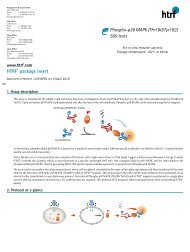

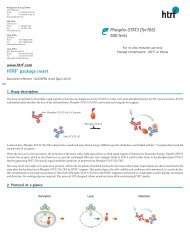
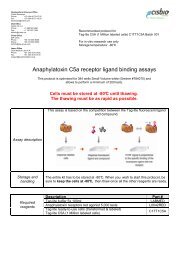
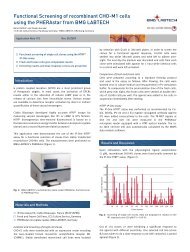
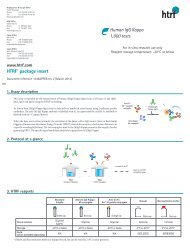
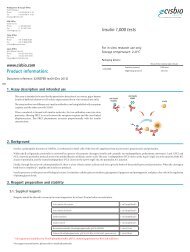

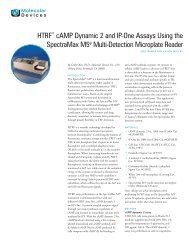
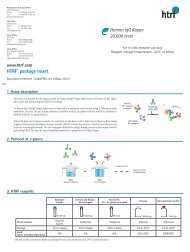
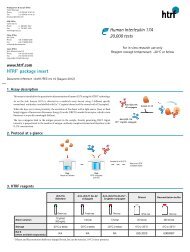

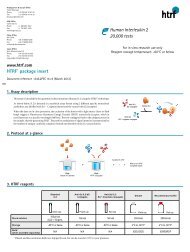
![HTRF meeting_130426_villa_pour pdf [Mode de compatibilité]](https://img.yumpu.com/22345646/1/190x135/htrf-meeting-130426-villa-pour-pdf-mode-de-compatibilitac.jpg?quality=85)